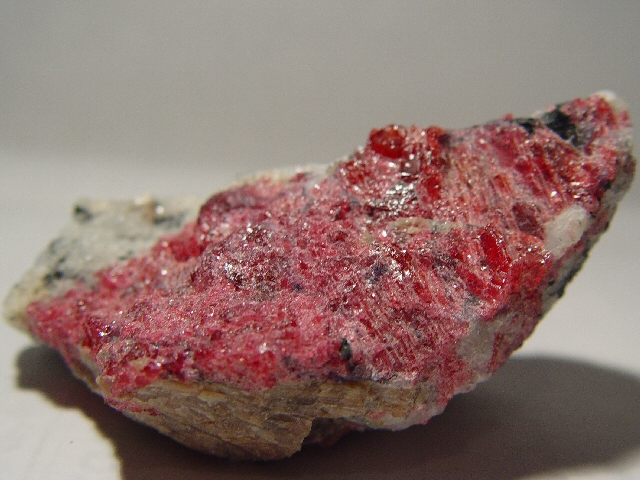- Eudialyte
Infobox mineral
name = Eudialyte
category =
boxwidth =
boxbgcolor =

caption =
formula = sodium15calcium6(iron,manganese)3 zirconium3siliconoxygen(oxygen,hydroxide,hydrogen2oxygen)3(silicon3oxygen9)2(silicon9oxygen27)2 (hydroxide,chlorine)2
molweight =
color = Red, magenta, brown; also blue and yellow
habit = Granular, tabular
system = Trigonal
twinning =
cleavage = [0001] Imperfect
fracture = Uneven
mohs = 5 - 5.5
luster = Vitreous
refractive = 1.598 - 1.602
opticalprop =
birefringence =
pleochroism = Weak, brown-red to red-pink to yellow
streak = White
gravity = 2.8 - 3
melt =
fusibility =
diagnostic =
solubility = H2SO4
diaphaneity = Transparent to translucent
other =Eudialyte, whose name derives from the Greek "eu" and "dialytos", meaning "well decomposable", is a somewhat rare, red
silicate mineral , which forms inalkaline igneous rocks, such asnepheline syenite s. Its name alludes to its ready solubility in acid.Uses of eudialyte
Eudialyte is used as a minor ore of
zirconium . Another use of eudialyte is as a minorgemstone , but this use is limited by its rarity, which is compounded by its poor crystal habit. These factors make eudialyte of primary interest as a collector's mineral.Associated minerals
Eudialyte is found associated with other alkalic igneous minerals, in addition to the some minerals common to most igneous material in general. These minerals include:
*nepheline , (sodium, potassium)aluminumsiliconoxygen4
*aegirine , sodiumironsilicon2oxygen6
*natrolite , sodium2aluminum2silicon3oxygen10hydrate|2
*albite, sodiumaluminumsilicon3oxygen8Alternative names
Alternative names of eudialyte include: almandine spar and eudalite. Eucolite is the name of an altered form.
Notes for identification
Eudialyte's rarity makes locality useful in its identification. Prominent localities of eudialyte include
Mont Saint-Hilaire inCanada and theKola Peninsula inRussia , but it is also found inGreenland ,Norway , andArkansas . The lack of crystal habit, associated with color, is also useful for identification, as are associated minerals. A pink-red mineral with no good crystals associated with other alkaline igneous material, especially nepheline and aegirine, is a good indication a specimen is eudialyte.Eudialyte group
Microchemical (by electron microprobe) and structural analyzes of different eudialyte (and related) samples revealed presence of many new eudialyte-like minerals. These minerals are structurally and chemically related and joined into eudialyte group. The group includes Zr-,OH-, Cl-, F-, CO3- and possibly also SO4-bearing silicates of Na, K, H3O, Ca, Sr, REEs, Mn, Fe, Nb and W. Electron vacancies can be present in their structure, too.
References
* [http://www.webmineral.com/data/Eudialyte.shtml WebMineral Listing]
* [http://www.mindat.org/min-1420.html MinDat Listing]
* [http://mineral.galleries.com/minerals/silicate/eudialyt/eudialyt.htm Mineral Galleries]
Wikimedia Foundation. 2010.
